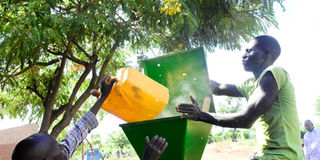'Machines reduce my farm work'

Machine crushing maize. PHOTOs by Edgar R. Batte.
What you need to know:
In total, Nicholas Mbijiwe has seven machines, three for flour processing from maize, sorghum, finger millet and wheat that he grows on part of his three acres for his own consumption and one that makes raw liquid porridge and three meant for making livestock feeds, writes Lominda Afedraru.
The first thing one hears when you step into Nicholas Mbijiwe’s farm, are machines roaring.
From one room one can hear what looks like a posho mill roaring as it grinds maize cobs.
At the cowshed, the chaff-cutter is busy slicing Napier grass and other fodder into tiny pieces.
A hammer machine, in a separate room, crushes various crop waste.
The farmer who keeps chickens, pigs and grows various crops has strived to mechanise his farm.
In total, Mbijiwe has seven machines, three for flour processing from maize, sorghum, finger millet and wheat that he grows on part of his three acres for his own consumption, one that makes raw liquid porridge and three meant for making livestock feeds.
The tools
The devices include the chaff cutter, the hammer machine and the mixer.
“I had bought the flour and porridge-making machines and the chaff cutter when I was still teaching in a Primary School. By then I had only five cows and they produced 23 litres a day, a thing that worried me,” he explains and adds, “In 2007, I opted for early retirement and came up with an agribusiness plan and calibrated my own hammer machine for crushing crop waste, which I have been using since then. I bought the mixer in 2012.”
These machines are what he uses to produce feeds for his 18 cows, nine which are in-calf, six are lactating while the rest are calves. The six cows offer him an average of 180 litres per day.
For the cows, Mbijiwe uses the chaff cutter to cut into pieces various types of fodder crops that include hay, calliandra, sorghum, maize, Napier grass and sorghum silage.
Dairy meal
He also processes his own dairy meal. “For the dairy meal, I use the post-harvest residue that include waste from beans, maize, wheat, barley, sunflower and cotton from my farm and add to what I buy from farmers during the harvesting season as most of them either burn
to ‘clean and clear’ their land or sell at a throw away price as they don’t need it.”
After collecting the waste, he uses the hammer machine, which crushes up to 3,000 kilogrammes of the residue per day, to grind them separately and pack it in different sacks.
Thereafter, he mixes the various ingredients in the mixer to end up with a complete dairy meal.
Mbijiwe recommends that, “When making cow meals, energy feeds that include maize bran, maize germ, maize cobs, wheat bran and pollard should form 68 per cent.”
While protein from sunflower and cotton seeds and cake forms 30 per cent.
“For the farmers who may not
understand the percentages, one can use kilos. Carbohydrates should comprise of 68 kilogrammes, proteins 30 kilogrammes and minerals two kilogrammes,” he offers.
Machines give more
On his farm, nothing goes to waste, thanks to the machines. What remains after being cut by the chaff-cutter is dried and ground in the hammer. It is then mixed with the dairy meal.
For his 12 pigs, he mixes wheat and maize bran and maize flour to make feeds. He also supplements their feeds with vegetables and kitchen waste.
“The reproduction rate of pigs is high as they can reproduce up to three times a year. And the good thing is that the animals have ready market, thus, offering a farmer more cash.”




